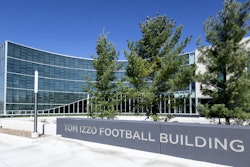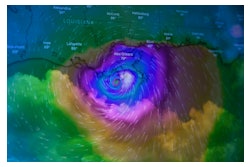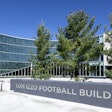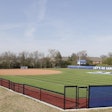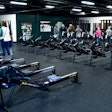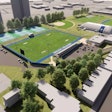This article originally appeared in the July 1983 issue of AB with the title, “The ‘New Age’ of Synthetic Turf Means Expanded Uses.”
Although synthetic turf has been around for almost 20 years, we are just now approaching a “new era” in its usage—an era characterized by expanding synthetic turf’s uses to include a myriad of athletic and recreational activities.
The next step in the evolution of synthetic turf, it appears, will occur not so much in advancement of turf for football and baseball, as in refinements geared to meet the needs of countless other activity areas.
Yes, synthetic turf will continue to be used for large area field sports—football, baseball, soccer, lacrosse, field hockey—plus band practice, marching drills and the like.
But what about running tracks, tennis courts, golf greens and tees, swimming pool areas, ski slopes, locker rooms, weight rooms, racing stables and playgrounds?
All of these areas are likely markets for suppliers of synthetic turf.
Key Advantages: Heavy Use, Low Maintenance
Synthetic turf was first used for sports at the fieldhouse at Moses Brown School in Providence, R.I., in 1964. Its first major application for sports was the Houston Astrodome in 1966. Since then, synthetic turf has gained its widespread popularity mainly for two reasons:
1) It allows continual, heavy use in any weather day after day, year after year; and
2) It requires minimal ongoing maintenance. These factors have helped account for synthetic turf finding its way into stadiums and playing fields across the country and around the world.
The next step, naturally, is to find new applications to take advantage of synthetic turf’s virtues.
In the early years, there were three primary turf manufacturers: The Monsanto Co., whose Astroturf went into the Astrodome, and soon became the standard of the industry; Minnesota Mining & Manufacturing (3M), which manufactured Tartan Turf; and American Built-Right of Boston, whose PolyTurf was installed in a few stadiums before being pulled off the market.
Like Built-Right, 3M eventually got out of the synthetic turf market. Monsanto’s Astroturf was the continuing turf available, and became almost a generic name for synthetic turf.
In recent years, other manufacturers have come on the scene. Prominent among them was the Chevron Co., whose fibers created an artificial surface that has been installed in many major stadiums.
Initially, Chevron marketed its turf under its own name; but it also sold to other marketers. Over time, a principal user of Chevron fibers became SuperTurf, In. The company has installed many SuperTurf surfaces across the country.
Since the mid-1970s, further changes have taken place in the synthetic turf market. Polyloom, Inc., is emerging as a major manufacturer of the fibers which are made into synthetic turf. Polyloom purchased the Chevron manufacturing formulas in 1980, and added in its own research and expertise, to produce the fibers it now makes.
At the present time, Polyloom has become important in the marketplace, because it supplies synthetic turf fibers to many different turf manufacturers.
Basically, it is a three-step process. First, Polyloom manufactures fibrillated (twisted) polypropylene fibers, made to the specifications of various carpet manufacturers to whom it will be supplied. Second, the carpet manufacturer (such as Playfield Industries, Inc.) will add its own undersurface and other materials needed for a finished installation. Third, a marketer of synthetic sports surfaces (such as All-Pro Turf or Omnisport International) will provide a finished surface to the user, and handle installation.
SuperTurf presently uses another petroleum giant, Amoco Oil, as a supplier of fibers for its turf. Monsanto, meanwhile, continues with its Astroturf and is the fabricator of all its components.
Different Characteristics for Different Uses
A major challenge for manufacturers in producing synthetic turf for various types of new uses is developing fibers and materials which meet the needs of the particular activity.
There are no clear definitions of what type of product is best for various installations. Suppliers in this field each have their own philosophy of what is best.
For example, Playfield offers its “Titan Turf” for indoor soccer installations. It is comprised of short Polyloom strands, tightly tufted to resemble a very thick, but short, grass surface. It is marketed and installed by All-Pro Turf, Inc.
Contrast that with Omnisport’s longer strand Polyloom fibers, more loosely tufted, and weighted down by a wet sand that is applied to the finished surface to create the Omnicourt tennis Surface.
Unfortunately for the end user, there has been very little published research on the various qualities of synthetic turf, according to Chauncey A. Morehouse, head of Penn State’s respected Sports Research Institute.
“There are little bits of information here and there,” says Morehouse. “But there have been no really definitive studies on such questions as abrasion, shock absorption, injuries—many of the biggest questions about artificial turf.
“One problem is that when you start comparing (artificial turf) with natural turf, you find that there is probably more difference within the range of natural turf—from a top-quality stadium used only a few times a year, to a concrete-hard high school field that gets little or not care—than among all the different synthetic turfs,” he said.
Morehouse said he knows of no comparative data from independent testing of synthetic turfs and materials. Perhaps there is a problem of revealing “trade secrets,” or of a fear of being “second best” in a very limited market.
Thus, it seems, the proving ground for the various new uses of synthetic turf will be out “in the field.”
To an extent, this process has already started.
All-Pro Turf, for instance, has complete installation of numerous soccer fields as far afield as Saudi Arabia and Argentina.
Tennis surfaces from Omnisport have been installed in such locations as the All-England Lawn Tennis Club (Wimbledon), where it is used as a practice court in foul weather; the East Side Tennis Club in New York City; Ken Rosewall’s Surfer’s Paradise Tennis Center in Australia; and various other tennis facilities in the U.S. and abroad.
Playfield has manufactured a fabric that is used for synthetic ski slopes, marketed by Colorado Country of Buford, Ga. The firm recently contracted for a practice slope to be installed at Texas A&M University.
At Disney World in Florida, a PGA-sponsored golf course designed specifically for kids—called Wee Links—is using greens and tees of Polyloom fibers, installed by Omnisport.
SuperTurf, meanwhile, is marketing a synthetic turf running track. Previously, it made an installation at The Houstonian, a prestigious athletic club and fitness center.
It’s important to remember that “synthetic turf” is not a generic, all-inclusive term. It comes in a variety of different materials, thicknesses, tufts, deniers (yarn size), colorations and construction.
As you can see, today’s purchaser has more to consider than one would realize when specifying synthetic turf…and also more to select from.
One needs to be able to identify the amount and type of use to which the surface will be subjected; the environmental conditions; and the economic situation in order to arrive at a reasonable decision as to whether synthetic turf should be installed, and if so, what type would offer the greatest number of advantages.














